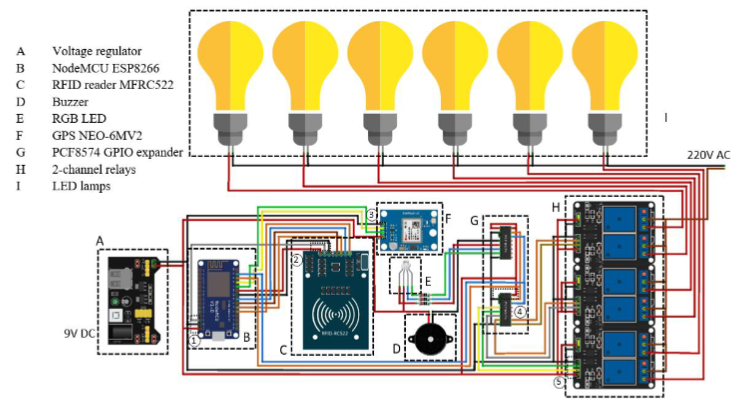Lighting system automation using a relay based on radio frequency identification tag input and kiosks’ information access with Telegram application in the modern market
DOI:
https://doi.org/10.23917/arstech.v4i1.1473Keywords:
Lighting automation, Internet of things, Lighting system, NodeMCU ESP8266, RFIDAbstract
Advancements in technology necessitate the swift and efficient management of systems, particularly concerning electricity consumption and information dissemination. To address this, a prototype was developed to automate lighting systems and display kiosk information in modern markets. Key components utilized include an RFID reader, GPS module, NodeMCU ESP8266, and relays, all of which played crucial roles in the functioning of the prototype. The primary objective was to create a device capable of automatically controlling the lighting system through relays, triggered by RFID inputs, while also relaying kiosk information via the Telegram application. For instance, when a registered RFID tag is tapped while the shop is open and the lamp is initially on, the lamp will be switched off, ensuring energy efficiency and timely response. The GPS module is employed to obtain location data, which, along with kiosk open/close status, can be conveniently accessed through the Telegram app. This integration of the GPS module enhances the prototype's functionality by providing valuable location-based information, making it easier for users to monitor and access the information remotely. Test results demonstrate that the RFID tag can be read from a maximum distance of 4.5 cm, with an average processing time of 2.47 seconds for lamp switching and 5.6 seconds for accessing information. These performance metrics validate the efficacy of the prototype methodology in achieving its intended goals of automation, energy efficiency, and seamless information dissemination in modern markets.
Downloads
References
M. Ricky and H. Habibullah, "Arduino UNO-Based room lighting automation", Jurnal Teknik Elektro Indonesia, vol. 3, no. 1, pp. 63–73, 2022. https://doi.org/10.24036/jtein.v3i1.204
Direktorat Jenderal Energi Baru Terbarukan dan Konservasi Energi – EBTKE https://ebtke.esdm.go.id/ [Accessed: March 2022].
H. Ahmad. "Design of Internet of Things (IoT) implementation on the operation of home light control based on voice commands and digital buttons using NodeMCU ESP8266 V.3 ", PhD dissertation, STMIK AKAKOM Yogyakarta, 2020. http://eprints.akakom.ac.id/id/eprint/8929
J. Julaiha and B. Rahmani, "Motion sensor-based toilet lighting system model using Atmega328 microcontroller", Progresif: Jurnal Ilmiah Komputer, vol. 18, no. 1, pp.11–22, Feb. 2022. http://dx.doi.org/10.35889/progresif.v18i1.780
F. Christian. "Design of a prototype automation system based on a microcontroller for room lighting at UAJY", PhD dissertation, UAJY, 2017. http://e-journal.uajy.ac.id/id/eprint/12455
S. Supatmi, "The effect of LDR sensor on light control", Majalah Ilmiah UNIKOM, vol. 8, no. 2, pp.175–179, 2011. https://repository.unikom.ac.id/id/eprint/30516
E. Desyantoro, A.F. Rochim, and K.T. Martono, "Automatic control system for electronic equipment in the house using PIR, LM35, and LDR Sensor," Jurnal Teknologi dan Sistem Komputer, vol. 3, no. 3, pp.405–411, 2015. https://doi.org/10.14710/jtsiskom.3.3.2015.405-411
A. Satriadi, W. Wahyudi, and Y. Christyono, "NodeMCU-Based home automation design," Transient: Jurnal Ilmiah Teknik Elektro, vol. 8, no. 1, pp.64–71, 2019. https://doi.org/10.14710/transient.v8i1.64-71
K.P. Aji, U. Darussalam, and N.D. Nathasia, "IoT-based employee presence system using RFID and NodeMCU ESP8266", Journal of Information Technology and Computer Science (JOINTECS), vol. 5, no. 1, pp.25–32, 2020. https://doi.org/10.31328/jointecs.v5i1.1222
A. Jadid, Z. Zulhelmi, and A. Ardiansyah, "RFID-based auto ID lecturement system design integrated with a web-based database", Jurnal Komputer, Informasi Teknologi, dan Elektro, vol. 2, no. 2, 2017. https://jurnal.usk.ac.id/kitektro/article/view/8066/0
C.J. Hegarty, 'The global positioning system (GPS)', Springer Handbook, pp.197–218, 2017. https://doi.org/10.1007/978-3-319-42928-1_7
N.M. Siregar, H. Muhammad, and R. Wicaksono, "Arduino UNO-based locker using RFID MFRC522", AUTOCRACY: Jurnal Otomasi, Kendali, Dan Aplikasi Industri, vol. 3, no. 2, pp.140–148, 2016. http://journal.unj.ac.id/unj/index.php/autocracy/article/view/6875
G. Sastrawangsa, "Utilisation of telegram bot to automate student services and information in the smart campus concept", E-Proceedings KNS&I STIKOM, Bali, pp.772–776, 2017. http://knsi.stikom-bali.ac.id/index.php/eproceedings/article/view/138
F. Rak and J. Wiora, "Comparison of ESP programming platforms", Computer Science and Information Technologies, vol. 2, no. 2, pp.77–86, 2021. https://doi.org/10.11591/csit.v2i2.p77-86
Handsontec.com, "2Ch-relay", 20 December 2016. http://www.handsontec.com/dataspecs/2Ch-relay.pdf [Accessed: 25 August 2022]
K. Aravindhan, S.K.B. Sangeetha, K. Periyakaruppan, K. P. Keerthana, V. SanjayGiridhar and V. Shamaladevi, "Design of attendance monitoring system using RFID," 2021 7th International Conference on Advanced Computing and Communication Systems (ICACCS), pp.1628–1631, 2021. https://doi.org/10.1109/ICACCS51430.2021.9441704
U. Nanda and S.K. Pattnaik, "Universal asynchronous receiver and transmitter (UART)," 2016 3rd International Conference on Advanced Computing and Communication Systems (ICACCS), pp.1–5, 2016. https://doi.org/10.1109/ICACCS.2016.7586376
D. Levshun, A. Chechulin and I. Kotenko, "A technique for design of secure data transfer environment: Application for I2C protocol," 2018 IEEE Industrial Cyber-Physical Systems (ICPS), pp.789–794, 2018. https://doi.org/10.1109/ICPHYS.2018.8390807
C. T O'Sullivan, "Ohm's law and the definition of resistance", Physics Education, vol. 15, no. 4, pp.237, 1980. https://doi.org/10.1088/0031-9120/15/4/009
D. Yadav, Y. Singh, and H Gupta, "Controlling of relay using Raspberry Pi via Internet for home automation", International Journal of Advanced Research in Engineering and Technology (IJARET), vol. 9, no. 1, pp.1–11, 2018. http://www.iaeme.com/IJARET/issues.asp?JType=IJARET&VType=9&IType=1
N. Sadikin, M. Sari, and B. Sanjaya, "Smarthome using android smartphone, Arduino UNO microcontroller and relay module", Journal of Physics: Conference Series, vol. 1361, no. 1, p. 012035, 2018. https://doi.org/10.1088/1742-6596/1361/1/012035
S. Preradovic and N. Karmakar, "Chipless RFID tag with integrated sensor", SENSORS, 2010 IEEE, pp.1277–1281, 2010. https://doi.org/10.1109/ICSENS.2010.5690591
Y.P. Luh and Y.C. Liu, "Measurement of effective reading distance of UHF RFID Passive Tags", Modern Mechanical Engineering, vol. 3, no. 3, pp.115–120, 2013.
https://doi.org/10.4236/mme.2013.33016
NXP Semiconductors, "MFRC522", 4 Mei 2016. https://www.nxp.com/docs/en/data-sheet/MFRC522.pdf [Accessed: 1 September 2022]
M. Thothadri, "An analysis on clock speeds in Raspberry Pi pico and Arduino UNO microcontrollers", American Journal of Engineering and Technology Management, vol. 6, no. 3, pp.41–46, 2021. https://doi.org/10.11648/j.ajetm.20210603.13

Downloads
Published
How to Cite
Issue
Section
Categories
License
Copyright (c) 2023 Libratyan Jhon Ngalimin, Erma Triawati Christina, Desy Kristyawati

This work is licensed under a Creative Commons Attribution 4.0 International License.










